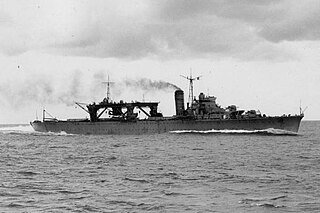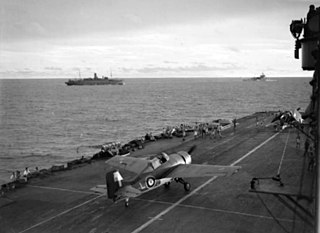
The German aircraft carrier Graf Zeppelin was the lead ship in a class of two carriers of the same name ordered by the Kriegsmarine of Nazi Germany. She was the only aircraft carrier launched by Germany and represented part of the Kriegsmarine's attempt to create a well-balanced oceangoing fleet, capable of projecting German naval power far beyond the narrow confines of the Baltic and North Seas. The carrier would have had a complement of 42 fighters and dive bombers.

A seaplane tender is a boat or ship that supports the operation of seaplanes. Some of these vessels, known as seaplane carriers, could not only carry seaplanes but also provided all the facilities needed for their operation; these ships are regarded by some as the first aircraft carriers and appeared just before the First World War.

Naval aviation is the application of military air power by navies, whether from warships that embark aircraft, or land bases.

Aquila was an Italian aircraft carrier converted from the trans-Atlantic passenger liner SS Roma. During World War II, Work on Aquila began in late 1941 at the Ansaldo shipyard in Genoa and continued for the next two years. With the signing of the Italian armistice on 8 September 1943, however, all work was halted and the vessel remained unfinished. Aquila was eventually scrapped in 1952.

A submarine aircraft carrier is a submarine equipped with aircraft for observation or attack missions. These submarines saw their most extensive use during World War II, although their operational significance remained rather small. The most famous of them were the Japanese I-400-class submarines and the French submarine Surcouf, although small numbers of similar craft were built for other nations' navies as well.

HMS Ark Royal was the first ship designed and built as a seaplane carrier. She was purchased by the Royal Navy in 1914 shortly after her keel had been laid and the ship was only in frames; this allowed the ship's design to be modified almost totally to accommodate seaplanes. During the First World War, Ark Royal participated in the Gallipoli Campaign in early 1915, with her aircraft conducting aerial reconnaissance and observation missions. Her aircraft later supported British troops on the Macedonian Front in 1916, before she returned to the Dardanelles to act as a depot ship for all the seaplanes operating in the area. In January 1918, several of her aircraft unsuccessfully attacked the German battlecruiser SMS Goeben when she sortied from the Dardanelles to attack Allied ships in the area. The ship left the area later in the year to support seaplanes conducting anti-submarine patrols over the southern Aegean Sea.

Seydlitz was a heavy cruiser of Nazi Germany's Kriegsmarine, fourth in the Admiral Hipper class, but was never completed. The ship was laid down in December 1936 and launched in January 1939, but the outbreak of World War II slowed her construction and fitting-out work was finally stopped in the summer of 1940 when she was approximately 95 percent complete. The unfinished ship remained pier-side in the shipyard until March 1942, when the Kriegsmarine decided to pursue aircraft carriers over surface combatants. Seydlitz was among the vessels chosen for conversion into auxiliary aircraft carriers.

HMS Pegasus was an aircraft carrier/seaplane carrier bought by the Royal Navy in 1917 during the First World War. She was laid down in 1914 by John Brown & Company of Clydebank, Scotland as SS Stockholm for the Great Eastern Railway Company, but construction was suspended by the start of the war. The ship was converted to operate a mix of wheeled aircraft from her forward flying-off deck and floatplanes that were lowered into the water. Pegasus spent the last year of the war supporting the Grand Fleet in the North Sea, but saw no combat. She spent most of 1919 and 1920 supporting British intervention against the Bolsheviks in North Russia and the Black Sea. The ship remained with the Mediterranean Fleet until 1924, but was placed in reserve in 1925 after a brief deployment to Singapore. Pegasus was sold for scrap in 1931.

HMS Riviera was a seaplane tender which served in the Royal Navy (RN) during the First and Second World Wars. Converted from the cross-Channel packet ship SS Riviera, she was initially fitted with temporary hangars for three seaplanes for aerial reconnaissance and bombing missions in the North Sea. She participated in the unsuccessful Cuxhaven Raid in late 1914 before she began a more thorough conversion in 1915 that increased her capacity to four aircraft. Riviera and her aircraft then spent several years spotting for British warship bombarding the Belgian coast and making unsuccessful attacks on targets in Germany. She was transferred to the Mediterranean in 1918 and returned to her owners the following year.

HMS Campania was a seaplane tender and aircraft carrier, converted from an elderly ocean liner by the Royal Navy early in the First World War. After her conversion was completed in mid-1915 the ship spent her time conducting trials and exercises with the Grand Fleet. These revealed the need for a longer flight deck to allow larger aircraft to take off, and she was modified accordingly. Campania missed the Battle of Jutland in May 1916, but made a number of patrols with elements of the Grand Fleet. She never saw combat and was soon relegated to a training role because of her elderly machinery. In November 1918 Campania was anchored with the capital ships of the Grand Fleet when a sudden storm caused her anchor to drag. With no second anchor being laid, she hit several of the ships and the collisions punctured her hull; she slowly sank, with no loss of life.
A scout plane is type of surveillance aircraft, usually of single-engined, two or three seats, shipborne type, and used for the purpose of discovering an enemy position and directing artillery. Therefore, a scout plane is essentially a small naval aircraft, as distinguished from a tactical ground observation aircraft, a strategic reconnaissance "spyplane", or a large patrol flying boat.

The Roon class was a pair of armored cruisers built for the German Kaiserliche Marine in the 1900s. The two ships of the class, Roon and Yorck, closely resembled the earlier Prinz Adalbert-class cruisers upon which they were based. The Roon class incorporated slight incremental improvements, including a pair of extra boilers. The ships were easily distinguished from their predecessors by the addition of a fourth funnel. Though the additional boilers were meant to increase the ships' speed, both vessels failed to reach their designed top speed. In addition, the ships had comparatively light armament and thin armor protection, so they compared poorly with their foreign contemporaries, particularly the armored cruisers of their primary opponent, the British Royal Navy.

Chiyoda was a light aircraft carrier of the Imperial Japanese Navy during World War II. Originally constructed as the second vessel of the Chitose-class seaplane tenders in 1934, she continued to operate in that capacity during the Second Sino-Japanese War and the early stages of the Pacific War until her conversion into a light aircraft carrier after the Battle of Midway. She was sunk during the Battle of Leyte Gulf by a combination of naval bombers, cruiser shellfire and destroyer-launched torpedoes.

HMS Vindex was a Royal Navy seaplane carrier during the First World War, converted from the fast passenger ship SS Viking. The ship spent the bulk of her career operating the North Sea, where she twice unsuccessfully attacked the German Zeppelin base at Tondern and conducted anti-Zeppelin patrols. One of her Bristol Scout aircraft made the first take-off from an aircraft carrier in late 1915. Another made the first interception of an airship by a carrier-based aircraft on 2 August 1916, when it unsuccessfully attacked the Zeppelin LZ 53. Vindex was transferred to the Mediterranean in 1918 and was sold back to her original owners in 1920. She was requisitioned again in 1939 and served through the Second World War as a troopship under a different name. After the end of the war, the ship was returned to her owners and was sold for scrapping in 1954.

Aircraft carriers are warships that evolved from balloon-carrying wooden vessels into nuclear-powered vessels carrying scores of fixed- and rotary-wing aircraft. Since their introduction they have allowed naval forces to project air power great distances without having to depend on local bases for staging aircraft operations.
The German aircraft carrier I was a planned conversion of the transport ship Europa during World War II. The loss of the battleship Bismarck and near torpedoing of her sistership Tirpitz in May 1941 and March 1942, respectively, spurred the Kriegsmarine to acquire aircraft carriers. Europa was one of several vessels selected for conversion into auxiliary aircraft carriers. As designed, the ship would have had an air complement of 24 Bf 109T fighters and 18 Ju 87C Stuka dive-bombers.
SMS Stuttgart was a Königsberg-class light cruiser of the Kaiserliche Marine, named after the city of Stuttgart. She had three sister ships: Königsberg, Nürnberg, and Stettin. Stuttgart was laid down at the Imperial Dockyard in Danzig in 1905, launched in September 1906, and commissioned in February 1908. Like her sisters, Stettin was armed with a main battery of ten 10.5 cm (4.1 in) guns and a pair of 45 cm (18 in) torpedo tubes, and was capable of a top speed in excess of 25 knots.
The Jade class comprised a pair of passenger ships intended to be converted into auxiliary aircraft carriers by Nazi Germany's Kriegsmarine during World War II. The two ships were launched as Gneisenau and Potsdam in 1935 and operated in peacetime by Norddeutscher Lloyd. After the outbreak of war, the ships were requisitioned by the Kriegsmarine as transports, and in May 1942, plans were drawn up to convert them into aircraft carriers. The ships were not identical, but were similar enough in size to allow identical outfitting.

Europa was a seaplane carrier of the Italian Regia Marina. Originally laid down as the merchant ship Manila, she was renamed Salacia in 1898, and then sold to German and then Italian shipping companies in 1911 and 1913, respectively. She became Quarto in 1913, and in February 1915 she was purchased by the Italian fleet, renamed Europa, and converted into a seaplane carrier with a capacity of eight seaplanes. She served as a seaplane base in Valona during World War I and supported the Allied response during the Battle of the Strait of Otranto in 1917. She was quickly sold for scrap in 1920 after the war ended.















